Microstructure and Mechanical Properties of Wire Laser Additive Manufactured Deposits and Their Tungsten Inert Gas Welds
Abstract
1. Introduction
2. Materials and Methods
2.1. Wire and Substrate Composition
2.2. WLAM Process Condition
2.3. TIG Welding Process Condition
2.4. Material Characterization
2.5. Mechanical Characterization
3. Results
3.1. Microstructure Observation
3.2. Mechanical Properties Comparison
4. Discussion
4.1. Microstructural Evolution and Its Impact on Tensile Properties
4.2. Ductility Variations in Deposited and Welded Materials
5. Conclusions
- Insufficient heat input or a slow wire feed rate during wire-feed AM and TIG welding results in internal defects such as lack of fusion and gas pores. These defects significantly degrade mechanical properties, with their impact proportional to defect size and fraction. Process optimization and post-weld heat treatment are essential to minimize defect formation and improve material performance.
- The microstructure of the Ti64 alloy varied significantly with cooling rates during the WLAM process. Low heat input and high scan speeds, as in sample B, created steep temperature gradients, leading to faster cooling rates and narrower prior β grain boundaries and lath α phases. However, the elemental partitioning of Ti, Al, and V due to cooling rate differences was not discernible under current analysis conditions.
- Deposits fabricated using laser heat sources exhibited faster cooling rates than TIG-welded materials, leading to narrower lath α phases and prior β grain boundaries with higher dislocation densities. Consequently, the deposits displayed superior yield strength and tensile strength. In contrast, welded materials showed reduced ductility due to mechanical anisotropy, stemming from the perpendicular orientation of prior β grain boundaries relative to the loading direction and the prevalence of α colony structures. These microstructural characteristics localized dislocation accumulation during deformation, exacerbating stress concentration and reducing plasticity.
- Both Ti64 deposits and welded materials exhibited quasi-brittle fracture characteristics, marked by a combination of dimples and cleavage regions on the fracture surfaces. While work hardening occurred during plastic deformation, indicating some dislocation activity, the high fraction of α phase with its HCP structure severely restricted overall slip activity, further contributing to the limited elongation and the transition to brittle fracture behavior observed at room temperature.
Author Contributions
Funding
Institutional Review Board Statement
Informed Consent Statement
Data Availability Statement
Conflicts of Interest
References
- Liu, R.; Wang, Z.; Sparks, T.; Liou, F.; Newkirk, J. Aerospace applications of laser additive manufacturing. In Laser Additive Manufacturing; Elsevier: Amsterdam, The Netherlands, 2017; pp. 351–371. [Google Scholar] [CrossRef]
- Lu, J.; Chang, L.; Wang, J.; Sang, L.; Wu, S.; Zhang, Y. In-situ investigation of the anisotropic mechanical properties of laser direct metal deposition Ti6Al4V alloy. Mater. Sci. Eng. A 2018, 712, 199–205. [Google Scholar] [CrossRef]
- Rae, W.; Lomas, Z.; Jackson, M.; Rahimi, S. Measurements of residual stress and microstructural evolution in electron beam welded Ti-6Al-4V using multiple techniques. Mater. Charact. 2017, 132, 10–19. [Google Scholar] [CrossRef]
- Dolev, O.; Osovski, S.; Shirizly, A. Ti-6Al-4V hybrid structure mechanical properties—Wrought and additive manufactured powder-bed material. Addit. Manuf. 2021, 37, 101657. [Google Scholar] [CrossRef]
- Rao, J.H.; Stanford, N. A survey of fatigue properties from wrought and additively manufactured Ti-6Al-4V. Mater. Lett. 2021, 283, 128800. [Google Scholar] [CrossRef]
- Zang, M.C.; Niu, H.Z.; Yu, J.S.; Zhang, H.R.; Zhang, T.B.; Zhang, D.L. Cryogenic tensile properties and deformation behavior of a fine-grained near alpha titanium alloy with an equiaxed microstructure. Mater. Sci. Eng. A 2022, 840, 142952. [Google Scholar] [CrossRef]
- Chen, Y.; Chen, X.; Jiang, M.; Lei, Z.; Wang, Z.; Liang, J.; Wu, S.; Ma, S.; Jiang, N.; Chen, Y. Coaxial laser metal wire deposition of Ti6Al4V alloy: Process, microstructure and mechanical properties. J. Mater. Res. Technol. 2022, 20, 2578–2590. [Google Scholar] [CrossRef]
- Elitzer, D.; Höppel, H.; Göken, M.; Baier, D.; Fuchs, C.; Bähr, H.; Meyer, T.; Gallasch, A. Influence of wire arc additive manufacturing of Ti-6Al-4V on microstructure and mechanical properties for potential large-scale aviation parts. MATEC Web Conf. 2020, 321, 03037. [Google Scholar] [CrossRef]
- Baufeld, B.; Brandl, E.; Van der Biest, O. Wire based additive layer manufacturing: Comparison of microstructure and mechanical properties of Ti–6Al–4V components fabricated by laser-beam deposition and shaped metal deposition. J. Mater. Process. Technol. 2011, 211, 1146–1158. [Google Scholar] [CrossRef]
- Åkerfeldt, P.; Pederson, R.; Antti, M.-L. A fractographic study exploring the relationship between the low cycle fatigue and metallurgical properties of laser metal wire deposited Ti–6Al–4V. Int. J. Fatigue 2016, 87, 245–256. [Google Scholar] [CrossRef]
- Karamimoghadam, M.; Rezayat, M.; Contuzzi, N.; Denora, V.; Mateo, A.; Casalino, G. Effect of wire feed rate on ER70S-6 microstructure of wire arc additive manufacturing process. Int. J. Adv. Manuf. Technol. 2025. [Google Scholar] [CrossRef]
- Åkerfeldt, P.; Antti, M.-L.; Pederson, R. Influence of microstructure on mechanical properties of laser metal wire-deposited Ti-6Al-4V. Mater. Sci. Eng. A 2016, 674, 428–437. [Google Scholar] [CrossRef]
- Ayed, A.; Bras, G.; Bernard, H.; Michaud, P.; Balcaen, Y.; Alexis, J. Study of Arc-wire and Laser-wire processes for the realization of Ti-6Al-4V alloy parts. MATEC Web Conf. 2020, 321, 03002. [Google Scholar] [CrossRef]
- Szost, B.A.; Terzi, S.; Martina, F.; Boisselier, D.; Prytuliak, A.; Pirling, T.; Hofmann, M.; Jarvis, D.J. A comparative study of additive manufacturing techniques: Residual stress and microstructural analysis of CLAD and WAAM printed Ti–6Al–4V components. Mater. Des. 2016, 89, 559–567. [Google Scholar] [CrossRef]
- Yamba, P.; Zhenying, X.; Yun, W.; Rong, W.; Xing, Y. Investigation of humping defect formation in a lap joint at a high-speed hybrid laser-GMA welding. Results Phys. 2019, 13, 102341. [Google Scholar] [CrossRef]
- Akman, E.; Demir, A.; Canel, T.; Sınmazçelik, T. Laser welding of Ti6Al4V titanium alloys. J. Mater. Process. Technol. 2009, 209, 3705–3713. [Google Scholar] [CrossRef]
- Liu, S.; Shin, Y.C. Additive manufacturing of Ti6Al4V alloy: A review. Mater. Des. 2019, 164, 107552. [Google Scholar] [CrossRef]
- Park, G.-W.; Song, S.; Park, M.; Shin, S.; Kim, D.-J.; Koo, Y.-M.; Kim, S.; Lee, K.-A.; Kim, B.J.; Park, S.S.; et al. Effect of residual stress on pore formation in multi-materials deposited via directed energy deposition. Addit. Manuf. 2024, 81, 104016. [Google Scholar] [CrossRef]
- Park, G.-W.; Shin, S.; Kim, J.-Y.; Koo, Y.-M.; Lee, W.; Lee, K.-A.; Park, S.S.; Jeon, J.B. Analysis of solidification microstructure and cracking mechanism of a matrix high-speed steel deposited using directed-energy deposition. J. Alloys Compd. 2022, 907, 164523. [Google Scholar] [CrossRef]
- Pegues, J.; Shao, S.; Shamsaei, N.; Sanaei, N.; Fatemi, A.; Warner, D.; Li, P.; Phan, N. Fatigue of additive manufactured Ti-6Al-4V, Part I: The effects of powder feedstock, manufacturing, and post-process conditions on the resulting microstructure and defects. Int. J. Fatigue 2020, 132, 105358. [Google Scholar] [CrossRef]
- Yadollahi, A.; Shamsaei, N.; Thompson, S.M.; Elwany, A.; Bian, L. Effects of building orientation and heat treatment on fatigue behavior of selective laser melted 17-4 PH stainless steel. Int. J. Fatigue 2017, 94, 218–235. [Google Scholar] [CrossRef]
- Yu, J.; Zhang, D.; Li, H.; Song, C.; Zhou, X.; Shen, S.; Zhang, G.; Yang, Y.; Wang, H. Detection of Internal Holes in Additive Manufactured Ti-6Al-4V Part Using Laser Ultrasonic Testing. Appl. Sci. 2020, 10, 365. [Google Scholar] [CrossRef]
- Zhou, Y.; Qin, G.; Li, L.; Lu, X.; Jing, R.; Xing, X.; Yang, Q. Formability, microstructure and mechanical properties of Ti-6Al-4V deposited by wire and arc additive manufacturing with different deposition paths. Mater. Sci. Eng. A 2020, 772, 138654. [Google Scholar] [CrossRef]
- Bambach, M.; Sizova, I.; Sydow, B.; Hemes, S.; Meiners, F. Hybrid manufacturing of components from Ti-6Al-4V by metal forming and wire-arc additive manufacturing. J. Mater. Process. Technol. 2020, 282, 116689. [Google Scholar] [CrossRef]
- Brandl, E.; Schoberth, A.; Leyens, C. Morphology, microstructure, and hardness of titanium (Ti-6Al-4V) blocks deposited by wire-feed additive layer manufacturing (ALM). Mater. Sci. Eng. A 2012, 532, 295–307. [Google Scholar] [CrossRef]
- Martina, F.; Colegrove, P.A.; Williams, S.W.; Meyer, J. Microstructure of interpass rolled wire+ arc additive manufacturing Ti-6Al-4V components. Metall. Mater. Trans. A 2015, 46, 6103–6118. [Google Scholar] [CrossRef]
- Squillace, A.; Prisco, U.; Ciliberto, S.; Astarita, A. Effect of welding parameters on morphology and mechanical properties of Ti–6Al–4V laser beam welded butt joints. J. Mater. Process. Technol. 2012, 212, 427–436. [Google Scholar] [CrossRef]
- Tavlovich, B.; Shirizly, A.; Katz, R. EBW and LBW of additive manufactured Ti6Al4V products. Weld. J. 2018, 97, 179S–190S. [Google Scholar] [CrossRef]
- Okamoto, Y.; Shinonaga, T.; Takemoto, Y.; Okada, A.; Ochi, A.; Kishimoto, R.; Pityana, S.; Arthur, N.; Omoniyi, P.; Mahamood, R. Study on joint characteristics in laser butt welding of AMed and wrought Ti6Al4V plates. Weld. World 2023, 67, 1997–2005. [Google Scholar] [CrossRef]
- Yu, H.; Li, F.; Yang, J.; Shao, J.; Wang, Z.; Zeng, X. Investigation on laser welding of selective laser melted Ti-6Al-4V parts: Weldability, microstructure and mechanical properties. Mater. Sci. Eng. A 2018, 712, 20–27. [Google Scholar] [CrossRef]
- Omoniyi, P.; Mahamood, R.; Arthur, N.; Pityana, S.; Skhosane, S.; Okamoto, Y.; Shinonaga, T.; Maina, M.; Jen, T.; Akinlabi, E. Joint integrity evaluation of laser beam welded additive manufactured Ti6Al4V sheets. Sci. Rep. 2022, 12, 4062. [Google Scholar] [CrossRef]
- Quan, Y.J.; Chen, Z.H.; Gong, X.S.; Yu, Z.H. Effects of heat input on microstructure and tensile properties of laser welded magnesium alloy AZ31. Mater. Charact. 2008, 59, 1491–1497. [Google Scholar] [CrossRef]
- Wang, J.; Lin, X.; Wang, M.; Li, J.; Wang, C.; Huang, W. Effects of subtransus heat treatments on microstructure features and mechanical properties of wire and arc additive manufactured Ti–6Al–4V alloy. Mater. Sci. Eng. A 2020, 776, 139020. [Google Scholar] [CrossRef]
- Syed, A.K.; Zhang, X.; Davis, A.E.; Kennedy, J.R.; Martina, F.; Ding, J.; Williams, S.; Prangnell, P.B. Effect of deposition strategies on fatigue crack growth behaviour of wire+ arc additive manufactured titanium alloy Ti–6Al–4V. Mater. Sci. Eng. A 2021, 814, 141194. [Google Scholar] [CrossRef]
- Wang, J.; Lin, X.; Li, J.; Hu, Y.; Zhou, Y.; Wang, C.; Li, Q.; Huang, W. Effects of deposition strategies on macro/microstructure and mechanical properties of wire and arc additive manufactured Ti6Al4V. Mater. Sci. Eng. A 2019, 754, 735–749. [Google Scholar] [CrossRef]
- Chekir, N.; Tian, Y.; Gauvin, R.; Brodusch, N.; Sixsmith, J.; Brochu, M. Effect of travel speed and stress relief on thin Ti-6Al-4V laser wire deposits. Mater. Sci. Eng. A 2018, 724, 335–347. [Google Scholar] [CrossRef]
- Hyer, H.C.; Petrie, C.M. Effect of powder layer thickness on the microstructural development of additively manufactured SS316. J. Manuf. Process. 2022, 76, 666–674. [Google Scholar] [CrossRef]
- Xie, Y.; Gao, M.; Wang, F.; Li, Q.; Zeng, X. A new recrystallization at semi-coherent micro-lamella and its effect on tensile properties of wire arc additive manufactured titanium alloy. Mater. Sci. Eng. A 2018, 737, 310–317. [Google Scholar] [CrossRef]
- Liu, J.; Zhang, K.; Gao, X.; Wang, H.; Wu, S.; Yang, Y.; Zhu, Y.; Huang, A. Effects of the morphology of grain boundary α-phase on the anisotropic deformation behaviors of additive manufactured Ti–6Al–4V. Mater. Des. 2022, 223, 111150. [Google Scholar] [CrossRef]
- Zhao, C.; Cheng, J.; Zhang, L.; Ouyang, W.; Sheng, L. Effect of rotating laser welding on microstructure and mechanical properties of Ti6Al4V alloy butt-welded joint. J. Mater. Sci. 2025, 60, 4864. [Google Scholar] [CrossRef]
- Alqawasmi, L.; Bijjala, S.T.; Khraishi, T.; Kumar, P. Evaluation of the Mechanical property heterogeneity in laser-directed energy deposited Ti-6Al-4V alloy. Int. J. Adv. Manuf. Technol. 2024, 136, 937–950. [Google Scholar] [CrossRef]
- Weng, F.; Bi, G.; Chew, Y.; Sui, S.; Tan, C.; Du, Z.; Su, J.; Ng, F.L. Robust interface and excellent as-built mechanical properties of Ti–6Al–4V fabricated through laser-aided additive manufacturing with powder and wire. Int. J. Miner. Metall. Mater. 2024, 32, 154–168. [Google Scholar] [CrossRef]
- Peng, F.C.; Guo, C.; Jiang, F.; Yuan, D.; Yin, H.; Sun, Q.; Zhang, H.; Dong, T.; Guo, D.; Konovalov, S. Microstructure evolution and mechanical properties of Ti-6Al-4V alloy fabricated by directed energy deposition assisted with dual ultrasonic vibration. Mater. Sci. Eng. A 2025, 925, 147934. [Google Scholar] [CrossRef]
- Lu, T.; Liu, C.; Li, Z.; Wu, Q.; Wang, J.; Xu, T.; Liu, J.; Wang, H.; Ma, S. Hot-wire arc additive manufacturing Ti–6.5 Al–2Zr–1Mo–1V titanium alloy: Pore characterization, microstructural evolution, and mechanical properties. J. Alloys Compd. 2020, 817, 153334. [Google Scholar] [CrossRef]
- Wu, B.; Pan, Z.; Ding, D.; Cuiuri, D.; Li, H.; Xu, J.; Norrish, J. A review of the wire arc additive manufacturing of metals: Properties, defects and quality improvement. J. Manuf. Process. 2018, 35, 127–139. [Google Scholar] [CrossRef]
- Lee, Y.; Kim, E.S.; Park, S.; Park, J.M.; Seol, J.B.; Kim, H.S.; Lee, T.; Sung, H.; Kim, J.G. Effects of laser power on the microstructure evolution and mechanical properties of Ti–6Al–4V alloy manufactured by direct energy deposition. Met. Mater. Int. 2022, 22, 197. [Google Scholar] [CrossRef]
- Moridi, A.; Demir, A.G.; Caprio, L.; Hart, A.J.; Previtali, B.; Colosimo, B.M. Deformation and failure mechanisms of Ti–6Al–4V as built by selective laser melting. Mater. Sci. Eng. A 2019, 768, 138456. [Google Scholar] [CrossRef]
- Shi, X.; Ma, S.; Liu, C.; Wu, Q.; Lu, J.; Liu, Y.; Shi, W. Selective laser melting-wire arc additive manufacturing hybrid fabrication of Ti-6Al-4V alloy: Microstructure and mechanical properties. Mater. Sci. Eng. A 2017, 684, 196–204. [Google Scholar] [CrossRef]
- Murr, L.; Esquivel, E.; Quinones, S.; Gaytan, S.; Lopez, M.; Martinez, E.; Medina, F.; Hernandez, D.; Martinez, E.; Martinez, J. Microstructures and mechanical properties of electron beam-rapid manufactured Ti–6Al–4V biomedical prototypes compared to wrought Ti–6Al–4V. Mater. Charact. 2009, 60, 96–105. [Google Scholar] [CrossRef]
- Zhang, S.; Weng, K.; Guo, C.; Zhao, H.; Lin, X.; Wang, L.; Yang, H.; Huang, W. The creep behavior of IN718 alloy fabricated by selective laser melting compared to forging. Appl. Mater. Today 2024, 38, 102252. [Google Scholar] [CrossRef]
- Tao, X.; Han, K.; Zhang, S.; Zhu, Y.; Zhang, B.; Yao, Z.; Liu, H. Effect of heat input on the microstructure and mechanical properties of Ti–6Al–4V alloy repaired by wire-feed electron beam additive manufacturing. J. Mater. Res. Technol. 2023, 25, 4674–4685. [Google Scholar] [CrossRef]
- Shchitsyn, Y.D.; Krivonosova, E.; Trushnikov, D.; Ol’Shanskaya, T.; Kartashov, M.; Neulybin, S. Use of CMT-surfacing for additive formation of titanium alloy workpieces. Metallurgist 2020, 64, 67–74. [Google Scholar] [CrossRef]
- Zhu, Y.; Li, J.; Tian, X.; Wang, H.; Liu, D. Microstructure and mechanical properties of hybrid fabricated Ti–6.5 Al–3.5 Mo–1.5 Zr–0.3 Si titanium alloy by laser additive manufacturing. Mater. Sci. Eng. A 2014, 607, 427–434. [Google Scholar] [CrossRef]
- Wu, C.; Zhao, Y.; Huang, S.; Sun, Q.; Zhou, L. Effect of cooling rate on α variant selection and microstructure evolution in a near β Ti–5Al–3Mo–3V–2Cr–2Zr–1Nb–1Fe alloy. J. Alloys Compd. 2020, 841, 155728. [Google Scholar] [CrossRef]
- Zhou, S.; Zhang, J.; Yang, G.; Wang, Y.; Li, B.; An, D.; Zheng, J.; Wei, W. Microstructure evolution and fracture behavior of Ti–6Al–4V fabricated by WAAM-LDM additive manufacturing. J. Mater. Res. Technol. 2024, 28, 347–362. [Google Scholar] [CrossRef]
- Fan, W.; Peng, Y.; Wang, Y.; Qi, Y.; Feng, Z.; Tan, H.; Zhang, F.; Lin, X. Effect of grain boundary Widmanstätten α colony on the anisotropic tensile properties of directed energy deposited Ti-6Al-4V alloy. J. Mater. Sci. Technol. 2024, 184, 145–156. [Google Scholar] [CrossRef]
- Zhao, Z.; Chen, J.; Lu, X.; Tan, H.; Lin, X.; Huang, W. Formation mechanism of the α variant and its influence on the tensile properties of laser solid formed Ti-6Al-4V titanium alloy. Mater. Sci. Eng. A 2017, 691, 16–24. [Google Scholar] [CrossRef]
- Paradkar, A.; Kamat, S.; Gogia, A.; Kashyap, B. On the validity of Hall–Petch equation for single-phase β Ti–Al–Nb alloys undergoing stress-induced martensitic transformation. Mater. Sci. Eng. A 2009, 520, 168–173. [Google Scholar] [CrossRef]
- Semiatin, S.; Bieler, T. The effect of alpha platelet thickness on plastic flow during hot working of TI–6Al–4V with a transformed microstructure. Acta Mater. 2001, 49, 3565–3573. [Google Scholar] [CrossRef]
- Dharmendra, C.; Hadadzadeh, A.; Amirkhiz, B.; Lloyd, A.; Mohammadi, M. Deformation mechanisms and fracture of electron beam melted Ti–6Al–4V. Mater. Sci. Eng. A 2020, 771, 138652. [Google Scholar] [CrossRef]
- Ma, H.Y.; Wang, J.; Qin, P.; Liu, Y.; Chen, L.; Wang, L.; Zhang, L. Advances in additively manufactured titanium alloys by powder bed fusion and directed energy deposition: Microstructure, defects, and mechanical behavior. J. Mater. Sci. Technol. 2023, 183, 32–62. [Google Scholar] [CrossRef]
- Carroll, B.E.; Palmer, T.A.; Beese, A.M. Anisotropic tensile behavior of Ti–6Al–4V components fabricated with directed energy deposition additive manufacturing. Acta Mater. 2015, 87, 309–320. [Google Scholar] [CrossRef]
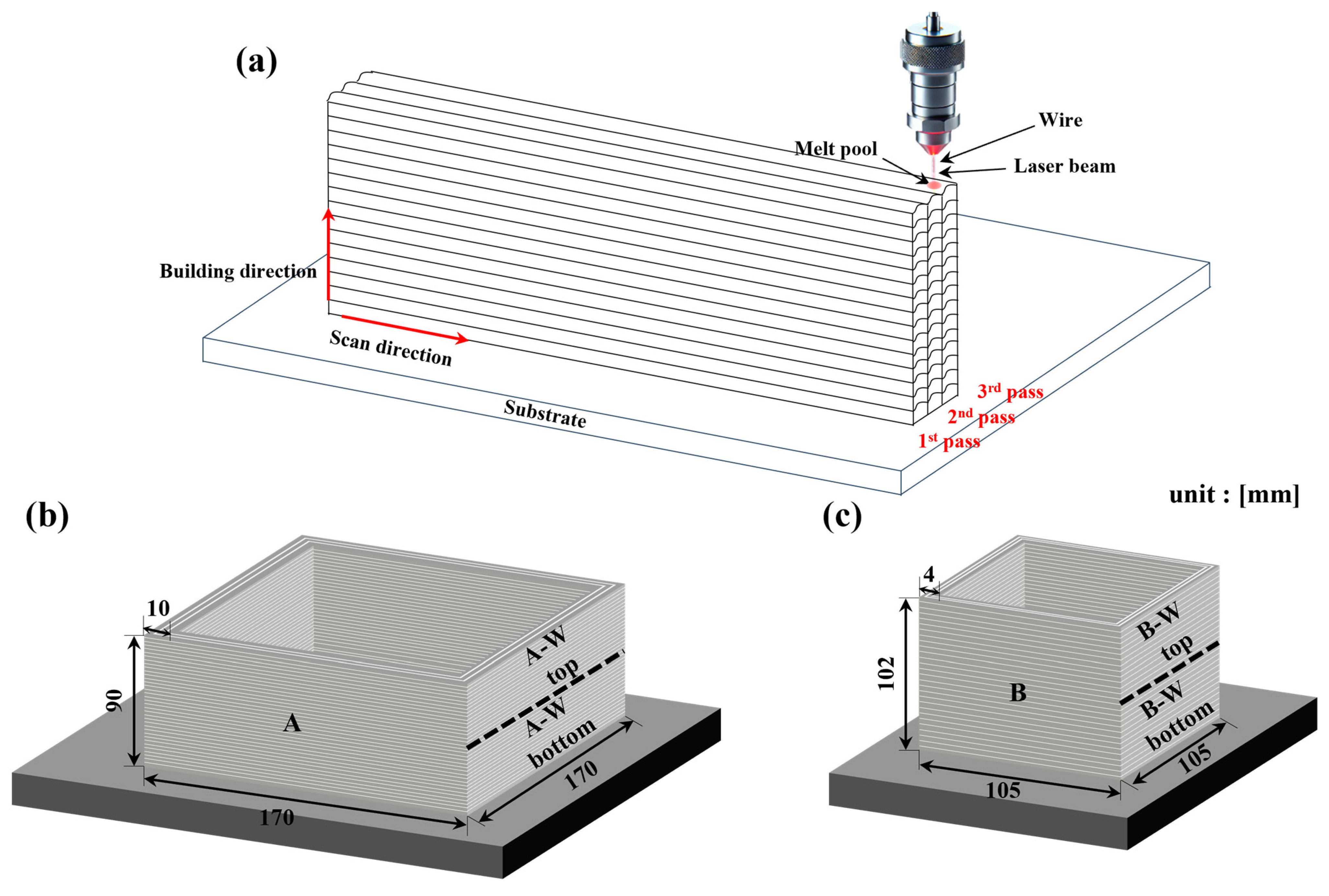

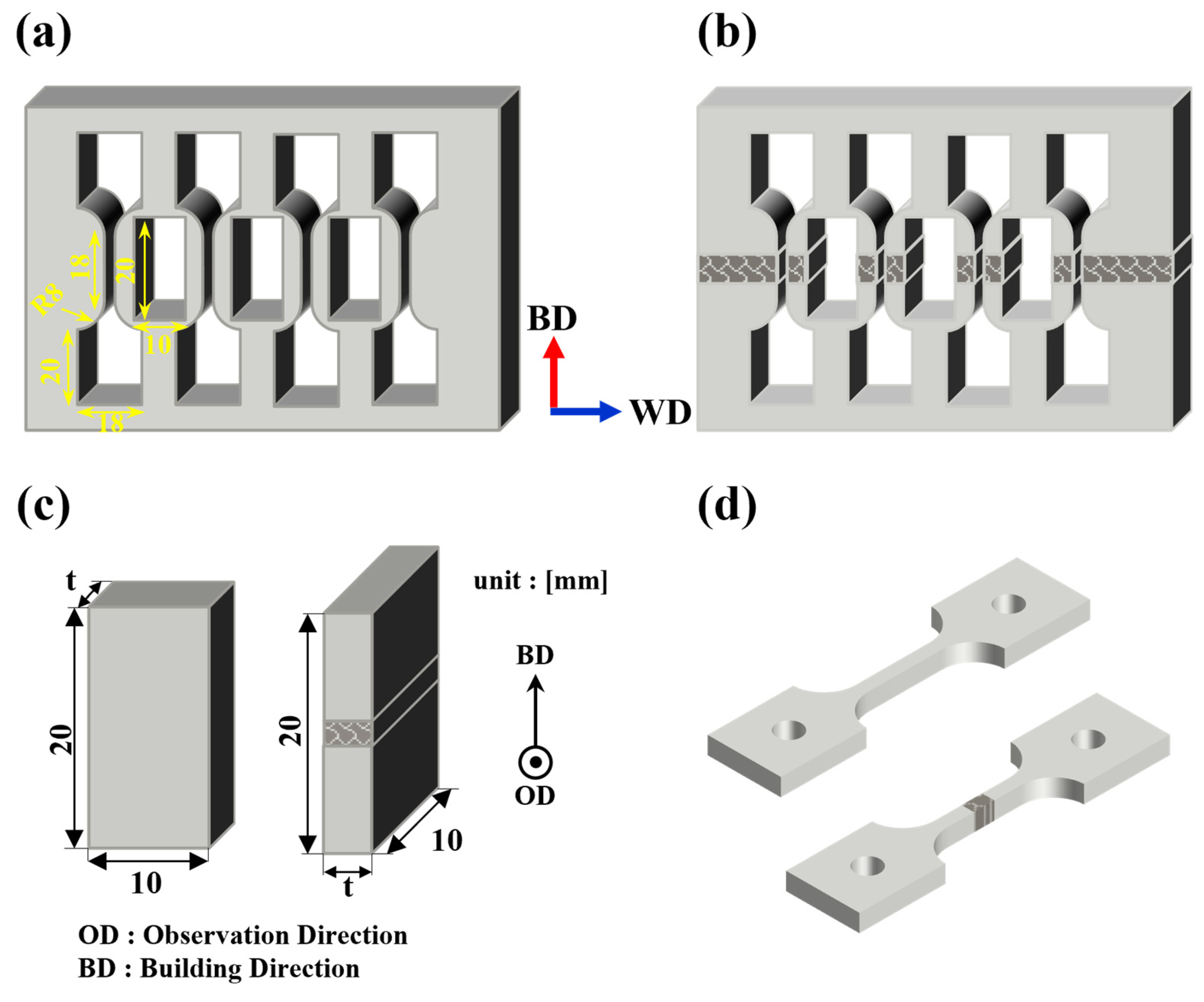

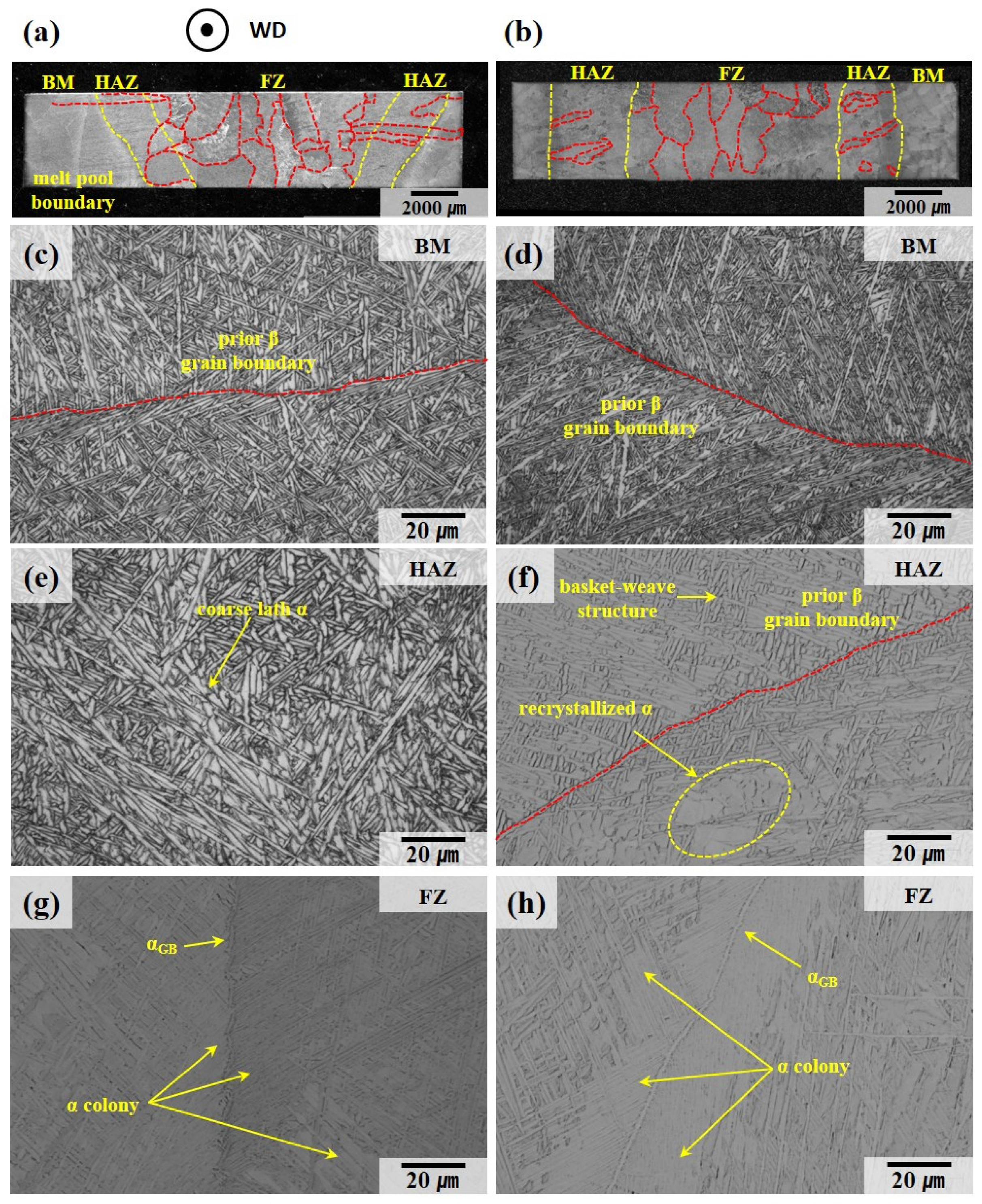

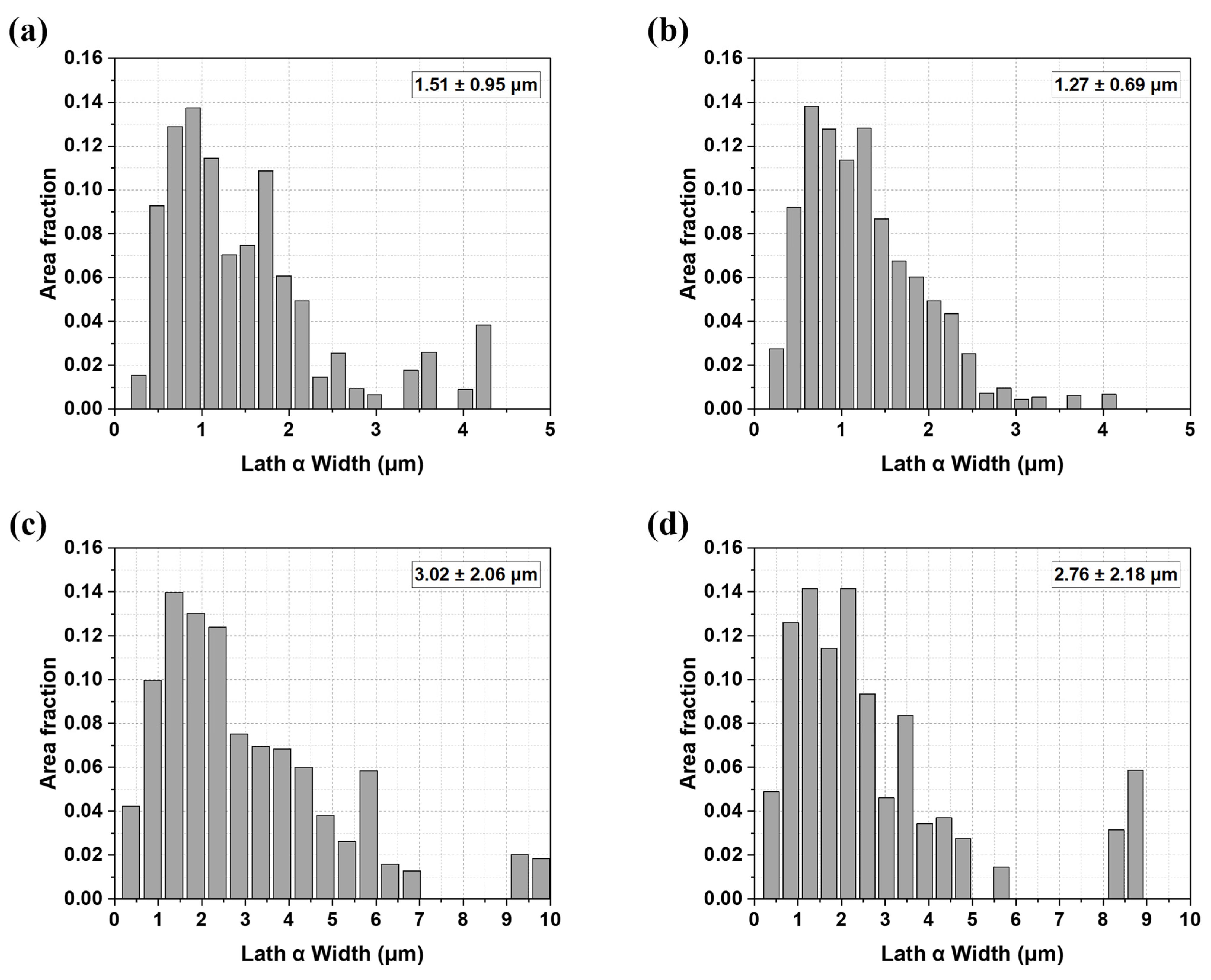
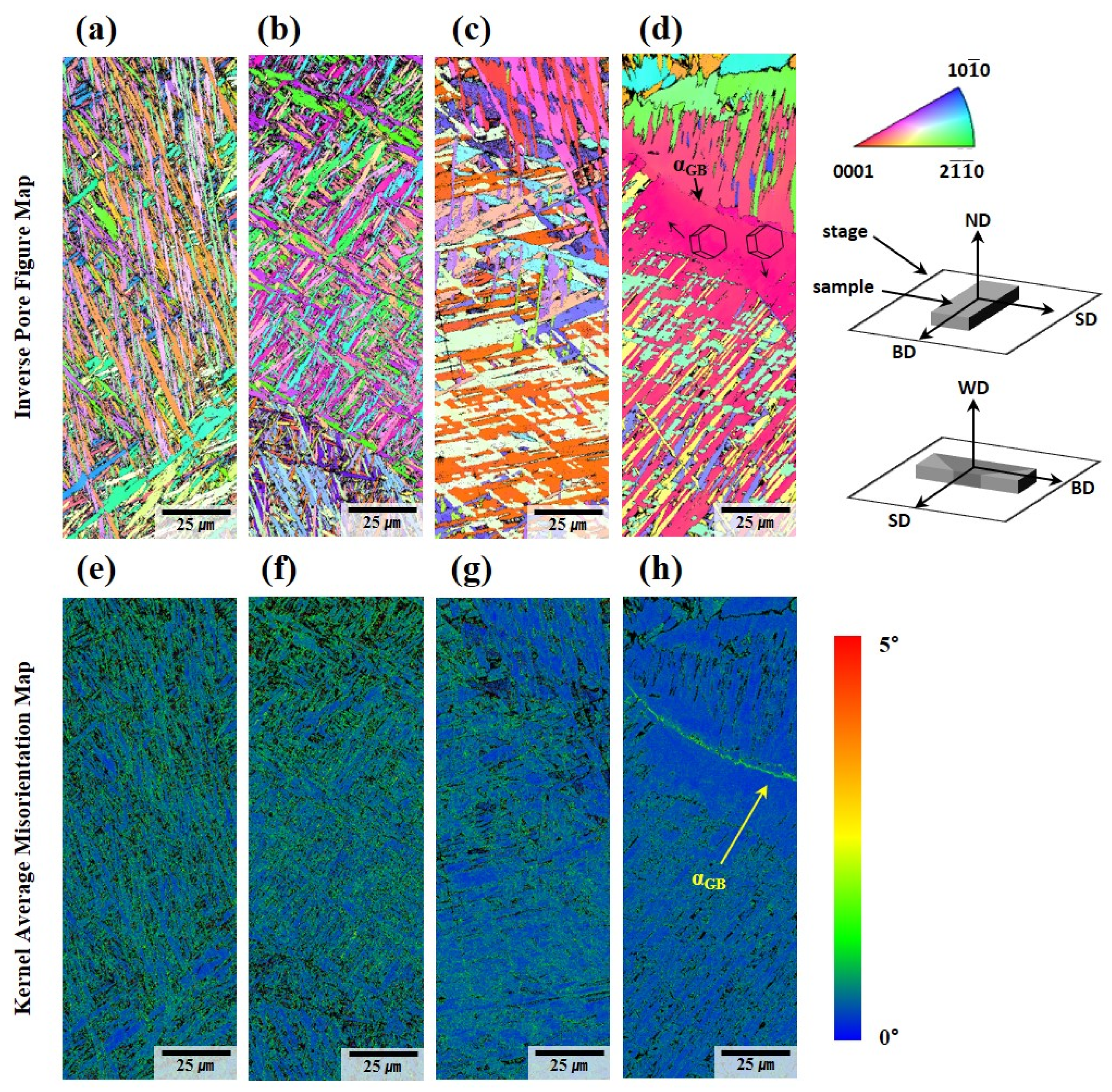
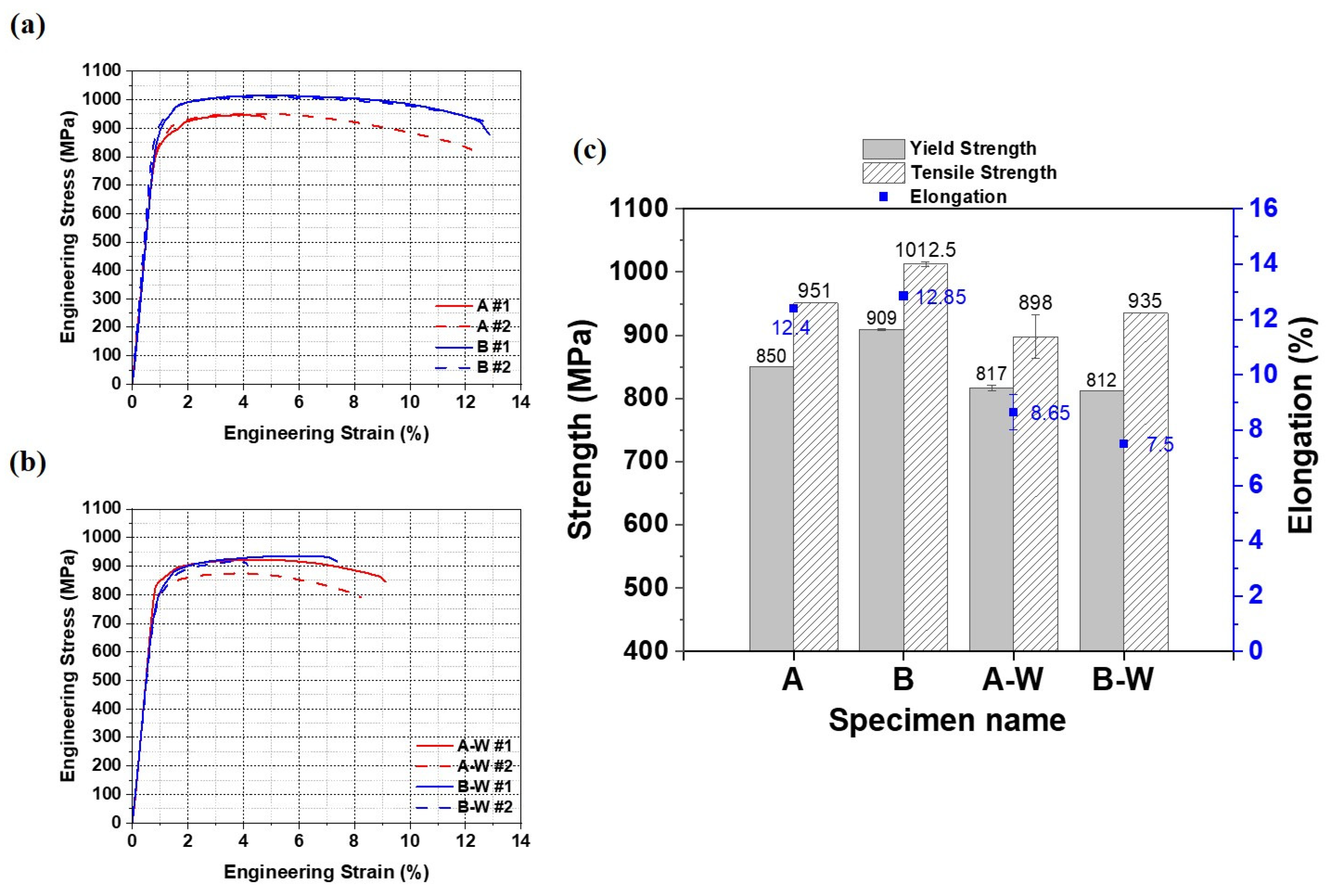
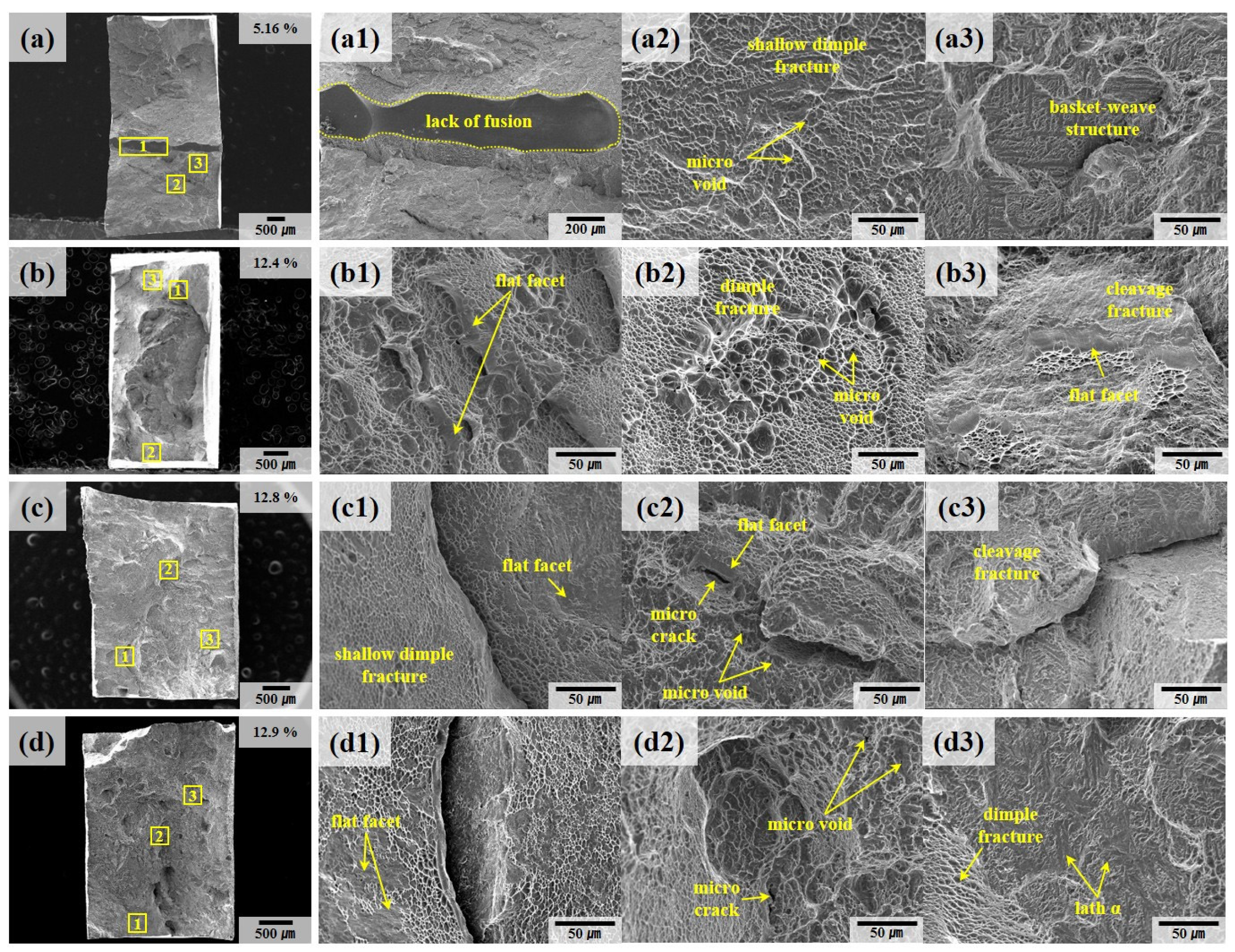
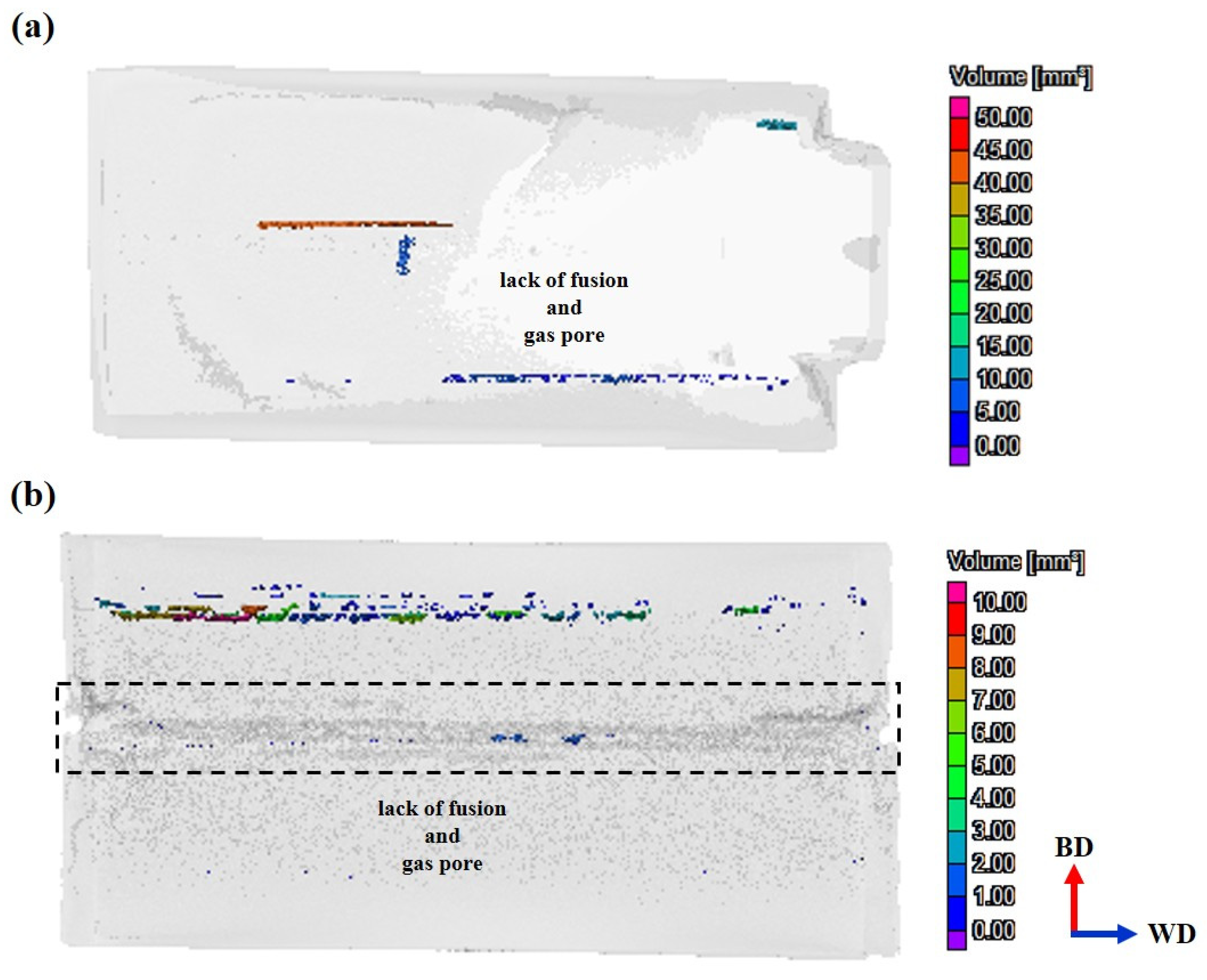
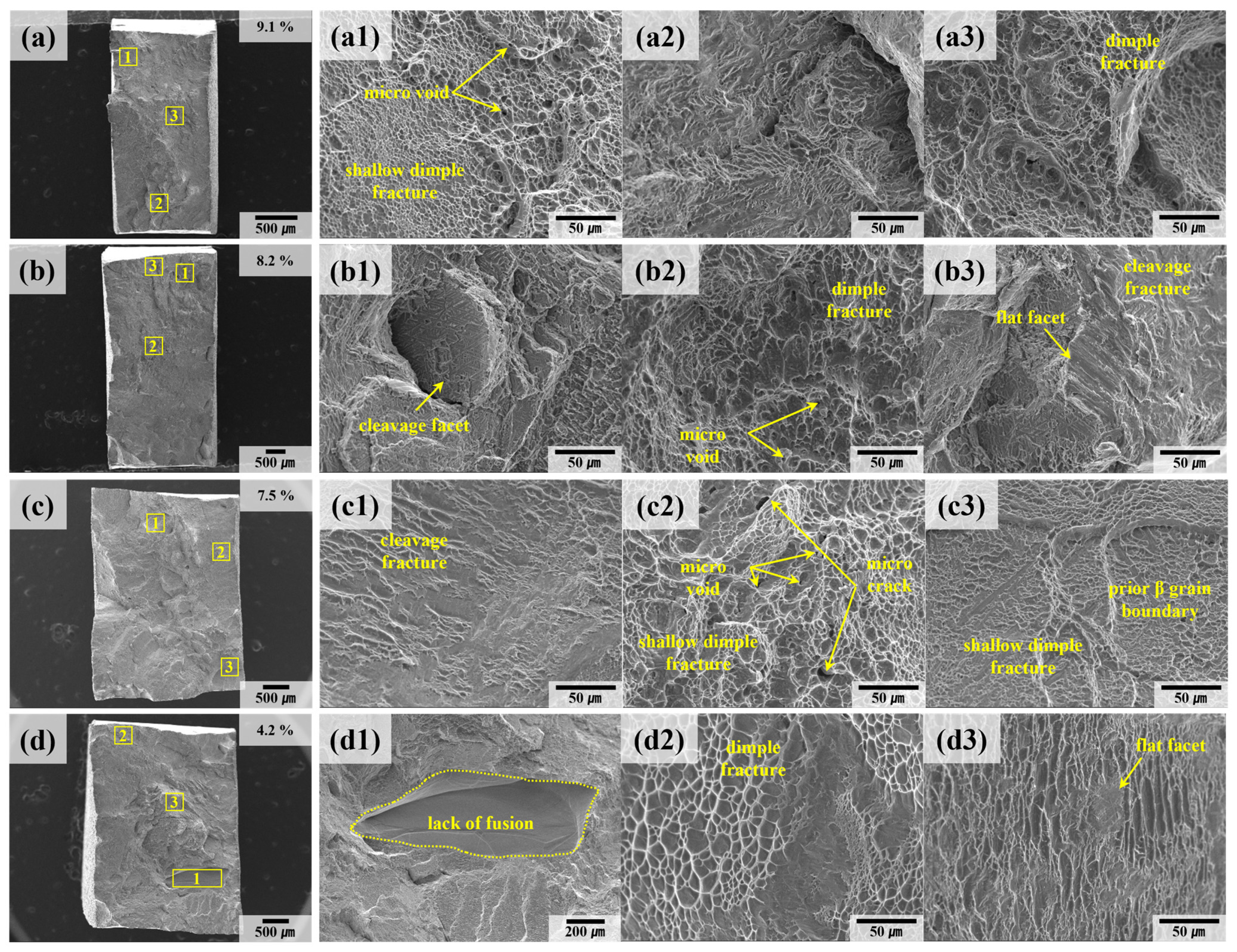
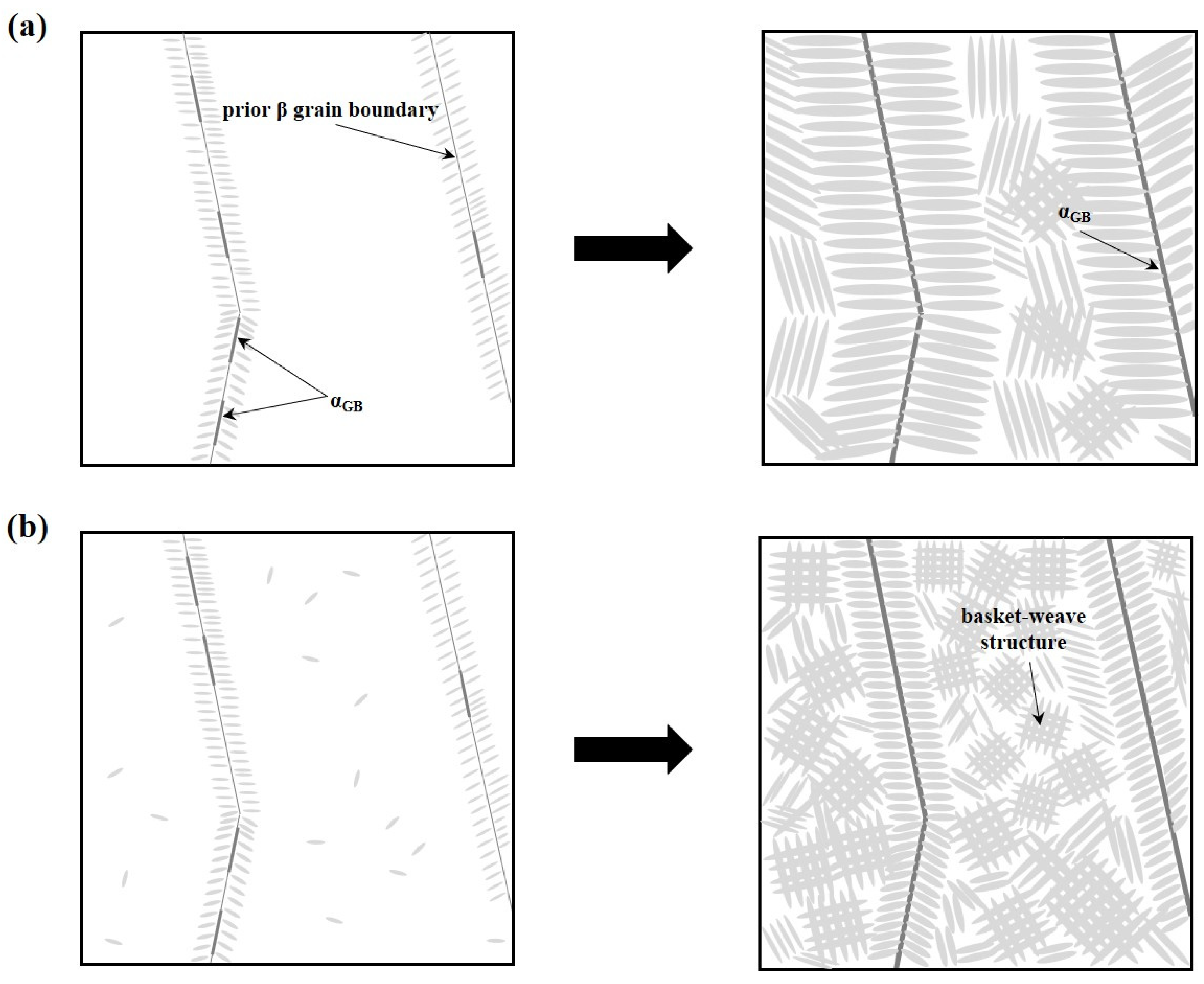
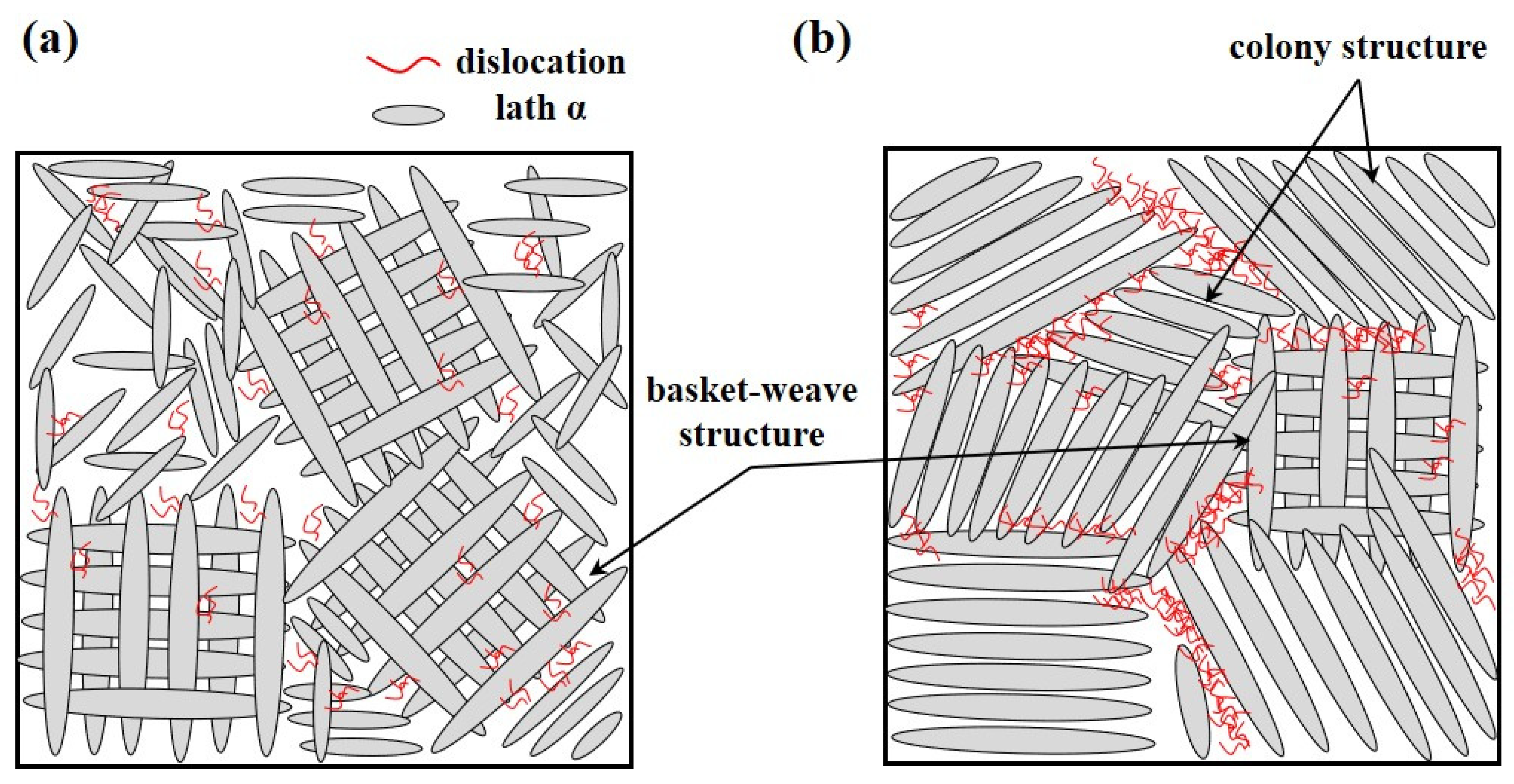
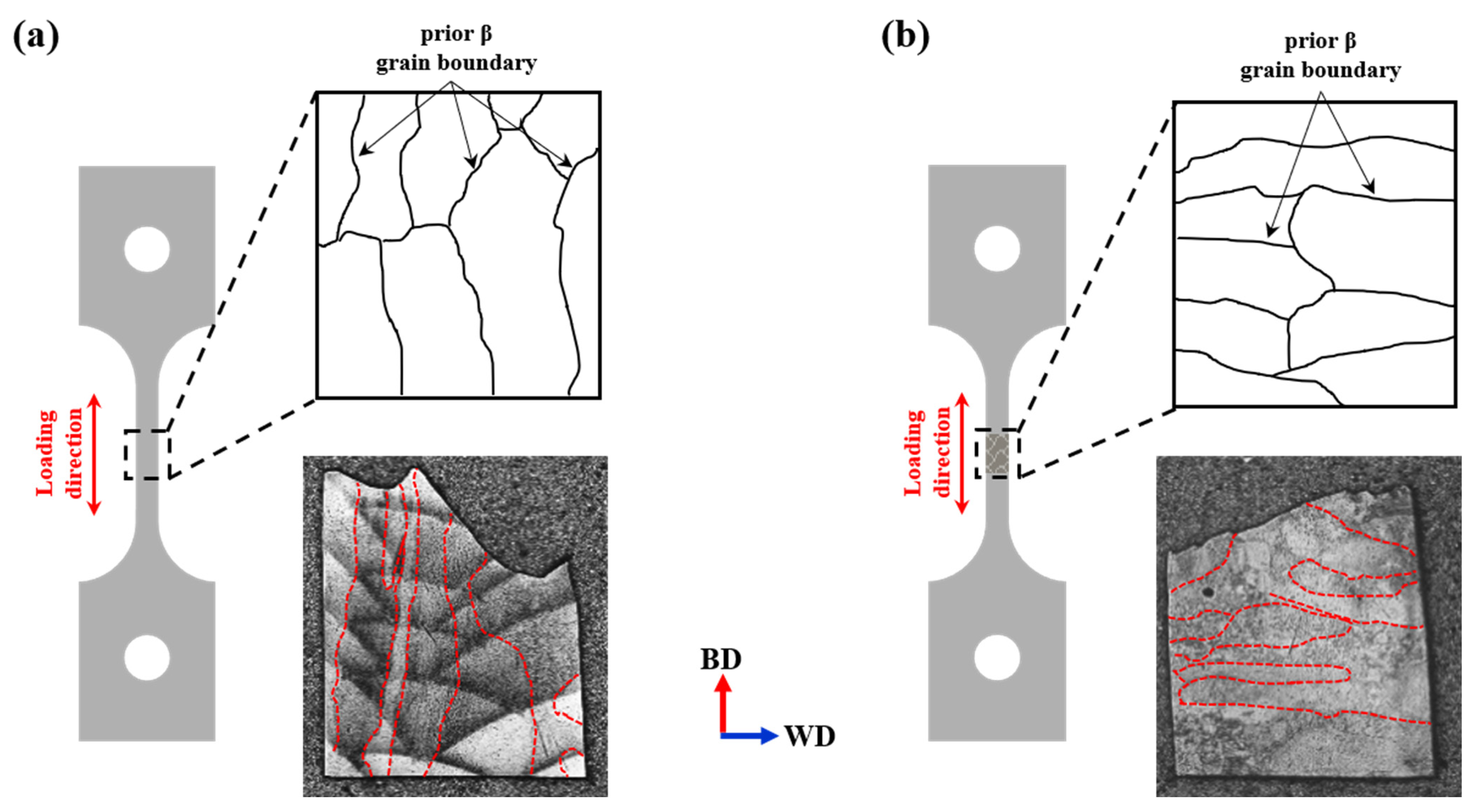
| wt. % | Ti | Al | V | Fe | C | Other |
|---|---|---|---|---|---|---|
| AM wire | Bal. | 5.5 | 3.5 | 0.4 | 0.08 | 0.22 |
| Weld wire | Bal. | 6.16 | 3.97 | 0.137 | 0.007 | 0.16 |
| Substrate | Bal. | 6.08 | 3.67 | 0.12 | 0.02 | 0.20 |
| WLAM Process Parameter | Sample A | Sample B |
|---|---|---|
| Laser beam power (W) | 3200 | 900 |
| Laser scan speed (mm/min) | 500 | 600 |
| Wire feed rate | 2.5–3.5 (m/min) | 15.3 (mm/s) |
| Scan path | 3 | 3 |
| Yield Strength (MPa) | Tensile Strength (MPa) | Elongation (%) | |
|---|---|---|---|
| A #1 | 808 | 945 | 5.15 |
| A #2 | 850 | 951 | 12.4 |
| B #1 | 910 | 1015 | 12.8 |
| B #2 | 908 | 1010 | 12.9 |
| A-W #1 | 820 | 922 | 9.1 |
| A-W #2 | 814 | 874 | 8.2 |
| B-W #1 | 812 | 935 | 7.5 |
| B-W #2 | 804 | 917 | 4.2 |
Disclaimer/Publisher’s Note: The statements, opinions and data contained in all publications are solely those of the individual author(s) and contributor(s) and not of MDPI and/or the editor(s). MDPI and/or the editor(s) disclaim responsibility for any injury to people or property resulting from any ideas, methods, instructions or products referred to in the content. |
© 2025 by the authors. Licensee MDPI, Basel, Switzerland. This article is an open access article distributed under the terms and conditions of the Creative Commons Attribution (CC BY) license (https://creativecommons.org/licenses/by/4.0/).
Share and Cite
Shim, Y.R.; Kim, J.K.; Jo, D.H.; Yang, H.P.; Yoon, S.W.; Yu, U.Y.; Lee, H.; Eo, D.; Yoon, J.C.; Shin, S.; et al. Microstructure and Mechanical Properties of Wire Laser Additive Manufactured Deposits and Their Tungsten Inert Gas Welds. Materials 2025, 18, 1308. https://doi.org/10.3390/ma18061308
Shim YR, Kim JK, Jo DH, Yang HP, Yoon SW, Yu UY, Lee H, Eo D, Yoon JC, Shin S, et al. Microstructure and Mechanical Properties of Wire Laser Additive Manufactured Deposits and Their Tungsten Inert Gas Welds. Materials. 2025; 18(6):1308. https://doi.org/10.3390/ma18061308
Chicago/Turabian StyleShim, Yeong Rae, Jong Kun Kim, Deok Hyun Jo, Hee Pyeong Yang, Seung Wook Yoon, Un Yong Yu, Hyub Lee, Durim Eo, Jong Cheon Yoon, Sunmi Shin, and et al. 2025. "Microstructure and Mechanical Properties of Wire Laser Additive Manufactured Deposits and Their Tungsten Inert Gas Welds" Materials 18, no. 6: 1308. https://doi.org/10.3390/ma18061308
APA StyleShim, Y. R., Kim, J. K., Jo, D. H., Yang, H. P., Yoon, S. W., Yu, U. Y., Lee, H., Eo, D., Yoon, J. C., Shin, S., Jung, J. E., & Jeon, J. B. (2025). Microstructure and Mechanical Properties of Wire Laser Additive Manufactured Deposits and Their Tungsten Inert Gas Welds. Materials, 18(6), 1308. https://doi.org/10.3390/ma18061308









